Learn how to create a Generative Design study using Dynamo for Revit and a sample study type.
This method of using Generative Design does not require a subscription to the AEC Collection or other qualifiers. It only requires access to Revit.
Objective: Create a study using the Stepped Grid Object Placement study type and a sample Revit model.
Steps
- Open and prepare the model in Revit.
- Use Dynamo to open the study type.
- Create a copy in a different location.
- Arrange the Dynamo and Revit windows.
- Locate Revit selection nodes.
- Select Revit elements.
- Run the study type to validate it.
- Create the study.
Open and prepare the model in Revit
- Optional: Read about the Grid Object Placement study type so you understand what it does and what it needs to run successfully.
- Download and open the sample model rac_advanced_sample_project.rvt.
- In the model, do the following:
- Open the 02 - Floor plan.
- Zoom in to the room in the upper left corner of the building, Lounge 223.
- Load the dining table family: Go to Insert
 Load Autodesk Family, and search for Table-Dining Round with Chairs. In the list of search results, click the dining table family, then click Load.
Note: For Table-Dining Round with Chairs, the family origin is defined as the center of the table. No changes are required to the origin.
Load Autodesk Family, and search for Table-Dining Round with Chairs. In the list of search results, click the dining table family, then click Load.
Note: For Table-Dining Round with Chairs, the family origin is defined as the center of the table. No changes are required to the origin.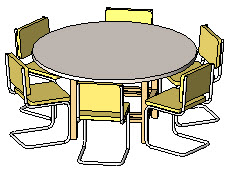
- Click Architecture tab
 Build panel
Build panel Component
Component Place a Component.
Place a Component.
- In the component properties, under Edit Type, select the desired table diameter for the family.
- Place an instance of the family in Lounge 223.
Then press ESC twice to exit the Place a Component tool.
- To make it easier to select elements in the model when creating the study, type VG to open the
Visibility/Graphics dialog. On the Model Categories tab, turn on visibility for the following:
- Furniture
- Rooms
 Interior Fill
Interior Fill
- Rooms
 Reference
Reference
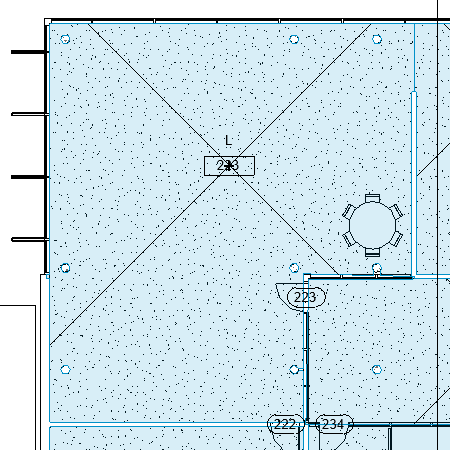
Use Dynamo to open the study type
- In
Revit, click Manage tab
 Visual Programming panel
Visual Programming panel Dynamo
Dynamo
 .
.
- In
Dynamo, open the study type:
- In the Dynamo window, under Files, click Open.
- Navigate to this location:
%PROGRAMDATA%\Autodesk\AECGD\Revit\Samples <release>\
- Open the folder for the desired language and locale, such as en-US for English-United States or fr-FR for French-France.
- Select Stepped Grid Object Placement.dyn, and click Open. In Dynamo, DYN files are called graphs.
Create a copy of the study type in a different location
The sample study types are read-only. Before using Stepped Grid Object Placement to create a study using Dynamo for Revit, you need to create a copy of it in another folder.
- In
Dynamo, click File
 Save As.
Save As.
- Navigate to another folder, enter a new file name if you want, and click Save. A dependencies folder is automatically created in the same folder with the graph.
Arrange the Dynamo and Revit windows
You want to see both windows at the same time.
- Move and resize the windows on your monitor so you can see both Dynamo and Revit.
- To see the entire study type, zoom and pan using the middle mouse button or the Zoom
 and Pan
and Pan
 controls.
controls.
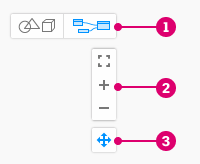
- Colored boxes group the nodes into logical functions or steps. On the left, the gray box provides documentation. Sample groups describe how the different colors are used in the graph.

Locate Revit selection nodes
In Dynamo, zoom in to the pink boxes on the left to find Revit selection nodes.
The Stepped Grid Object Placement study type has two selection nodes: Select family instance, and Select room.
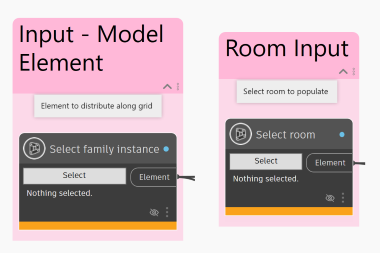
The remaining pink boxes indicate other types of inputs; you'll specify those inputs later using the Define Study dialog.
Select Revit elements
In the Revitmodel, select the room (Lounge 223) and the family instance (Table-Dining Round with Chairs) using selection nodes in Dynamo.
- Select the room as follows:
- Click the Select button on the Select room node.
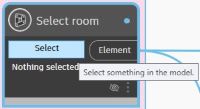
- In Revit, select the room for Lounge 223.
- In
Dynamo, confirm that the selection node displays an element ID. This is the ID of the room.
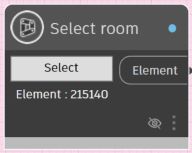
- Click the Select button on the Select room node.
- Select the table instance as follows:
- Click the Select button on the Select family instance node.
- In Revit, select the instance for Table-Dining Round with Chairs.
- In Dynamo, confirm that the selection node displays the element ID.
Run the graph to validate it
- In
Dynamo, if the Graph Status tab does not display in the right pane, on the menu bar click Extensions
 Show Graph Status.
Show Graph Status.
- In the Run Settings bar at the bottom of the
Dynamo window, click Run. (The keyboard shortcut is F5.) If the run settings are set to Automatic, the graph will run automatically.

- If any issues display in the Graph Status tab, review them. For each issue, click its links to jump to those spots in the graph where adjustments are needed.
- After addressing issues, re-run the graph until all issues are resolved.
- Save the graph. The graph (DYN file) is updated with the changes.
Create the study
After running the graph to validate it and saving it in Dynamo, create the study to generate multiple outcomes.
- On the menu bar, click Generative Design
 Create Study.
Create Study.
Wait a moment for the Create Study dialog to open. It may open in a different part of the screen.
- In the Create Study dialog, for Choose Folder, select the folder where the current study type resides. Then select the study type.
If the folder doesn't appear in the Choose Folder list, add it. Then select it from the Choose Folder drop-down list, and select the study type.
- In the Define Study dialog, complete the fields and click Generate.
The outcomes display in the Explore Outcomes dialog.
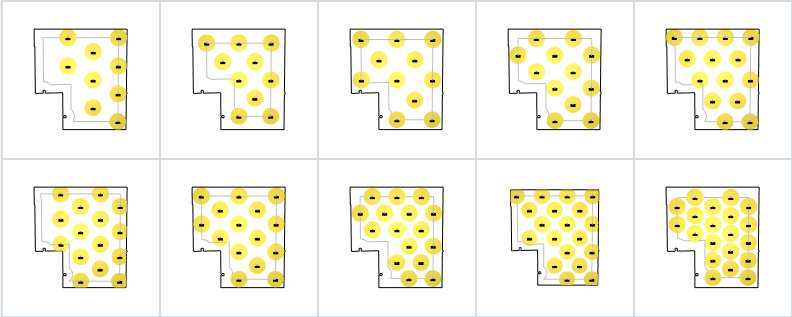
Now you can do the following:
- Explore more outcomes of the study. Examine their details.
- Create a new study using different criteria in the Define Study dialog.
- Integrate a selected outcome into the Revit model.

 in the
in the